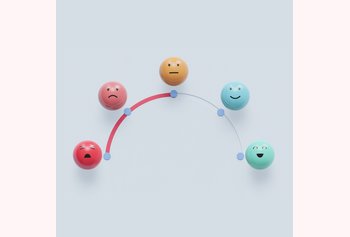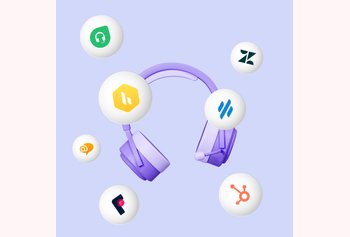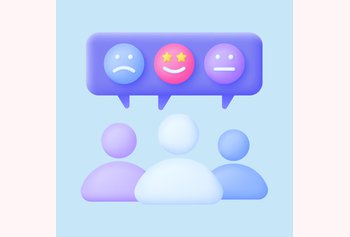11 Excellent Customer Engagement Strategies

Table of contents
Every business, whether big or small, has something unique to offer. But beyond the products or services lies a crucial element: the relationship with customers. This relationship, built on trust and consistent engagement, often becomes the cornerstone of a brand’s success.
Why? Because when customers feel valued and connected, they not only do repeat business but also become brand advocates.
From the initial interaction to fostering long-term loyalty, every touchpoint matters. This article offers actionable insights to enhance these interactions, ensuring that every customer feels heard, understood, and appreciated.
We’ll explore a range of customer engagement strategies that aim to strengthen this bond between businesses and their customers.
Table of Contents
- What is Customer Engagement?
- What is a Customer Engagement Strategy?
- Key Benefits of a Customer Engagement Strategy
- 11 Best Customer Engagement Strategies
- 7 Metrics to Measure the Success of a Customer Engagement Strategy
- Leverage Customer Engagement with Hiver
What is Customer Engagement?
Customer Engagement refers to the depth of the relationship a customer has with a brand or a company. It’s an assessment of the degree to which a customer interacts with a brand’s touchpoints, from advertisements and promotions to customer service interactions and product usage. The primary goal of customer engagement is to foster a strong connection between the customer and the company.
What is a Customer Engagement Strategy?
Customer Engagement Strategy is a comprehensive plan formulated by businesses to foster consistent and meaningful interactions with their customers across various touchpoints. This strategy aims to deepen the relationship between the customer and the brand.
A well-crafted customer engagement strategy not only focuses on attracting new customers but also emphasizes nurturing existing ones, ensuring they remain satisfied, and invested in the brand.
For example, a bookstore introduces a mobile app that sends personalized book recommendations to users based on their past purchases. Additionally, every time a user leaves a review or rates a book on the app, they earn points that can be redeemed for discounts. This strategy not only encourages customers to engage more with the app but also incentivizes them to make repeat purchases.
Key Benefits of a Customer Engagement Strategy
Implementing a robust customer engagement strategy offers a myriad of benefits to businesses. Here are the top benefits:
- Enhanced Customer Loyalty: By consistently offering value and fostering positive interactions, businesses can build a strong emotional connection with their customers, making them less likely to switch to competitors.
- Increased Sales and Revenue: Engaged customers tend to purchase more frequently and are more open to upselling or cross-selling opportunities. This leads to increased sales and, consequently, higher revenue.
- Valuable Feedback and Insights: Loyal customers are more likely to provide accurate feedback, whether positive or negative. This feedback is invaluable for businesses to improve their products, services, and overall customer experience.
- Enhanced Brand Advocacy: Highly engaged customers often become brand advocates. They are more likely to recommend a brand to friends and family, write positive reviews, and share their positive experiences on social media, leading to organic growth.
- Higher Lifetime Value: Engaged customers tend to stick around for longer and make more purchases over their lifetime. This increases their lifetime value, which is a significant metric for business profitability.
- Competitive Advantage: In industries where products and services are similar, customer engagement can be the differentiating factor. Brands that prioritize customer engagement often stand out and gain a competitive edge.
12 Best Customer Engagement Tools for Businesses
11 Best Customer Engagement Strategies
Customer engagement strategies are of different types. Here we provide a list of the 11 best strategies that you can apply to your business.
Strategy 1: Omnichannel Customer Support
Omnichannel customer support refers to offering consistent and seamless customer service across multiple channels, ensuring that customers can reach out to a brand through their preferred medium, be it email, phone, social media, live chat, or others, and receive a uniform experience.
For example, a popular e-commerce brand realizes that while many customers reach out via email, a significant portion prefers using social media and live chat. They implement an omnichannel support system, ensuring that customers receive timely and consistent responses regardless of the channel. As a result, customer satisfaction scores see a notable increase.
Benefits:
- Customers appreciate the flexibility to choose their preferred channel and receive consistent support.
- Agents can manage and track customer interactions more effectively when all channels are integrated.
- Seamless support experiences reduce customer frustration and increase loyalty.
Implementation:
- Determine which channels your customers use most frequently. This could be based on demographics, customer feedback, or industry trends.
- Use a customer support platform that integrates various channels, ensuring that agents have a unified view of customer interactions.
- Ensure that your customer support team is trained to handle inquiries across all channels and understands the nuances of each.
- Regularly gather feedback and analyze performance metrics to identify areas of improvement.
Strategy 2: Proactive Customer Support
Proactive customer support involves anticipating potential issues or questions customers might have and addressing them before they become problems. Instead of waiting for customers to reach out with issues, businesses take the initiative to provide solutions and information upfront.
Let’s say, a software company, after analyzing support tickets, realizes that many users struggle with a particular feature after updates. Instead of waiting for complaints, they create a detailed tutorial video and email it to users right after the update. This proactive approach leads to a significant drop in related support tickets.
Benefits:
- By addressing issues before they arise, the number of support inquiries can be significantly reduced.
- Customers appreciate businesses that anticipate their needs, leading to a more positive perception of the brand.
- Proactively addressing concerns demonstrates a brand’s commitment to customer well-being, fostering trust.
Implementation:
- Review past support tickets to identify recurring issues or questions.
- Develop FAQs, tutorials, how-to guides, or videos addressing these common concerns.
- Leverage tools that can predict potential issues based on customer behavior or product usage patterns.
- Actively reach out to customers through emails, notifications, or messages to inform them about potential issues and their solutions.
Strategy 3: Empowerment of Frontline Support Agents
Empowering frontline support agents refers to giving them the authority, tools, and training to make decisions on the spot to resolve customer issues. Instead of escalating matters or seeking approvals, empowered agents can take immediate action, leading to faster resolutions and enhanced customer satisfaction.
Benefits:
- Empowered agents go the extra mile, and truly WOW customers. They can address and resolve issues in real time, reducing wait times for customers.
- Empowerment can lead to increased job satisfaction and motivation among support agents, as they feel trusted and valued.
Implementation:
- Ensure that agents have in-depth knowledge of products, services, and company policies.
- Define the limits within which agents can make decisions, ensuring consistency and adherence to brand standards.
- Offer agents advanced CRM systems, knowledge bases, and other tools to access information quickly and make informed decisions.
- Create a feedback loop where agents can share their experiences, challenges, and suggestions for improvement.
Strategy 4: Real-time Feedback Collection and Analysis
This strategy involves collecting feedback from customers immediately after their interaction with the support team. By leveraging modern tools and technologies, businesses can gather insights in real time, allowing them to address concerns promptly and make continuous improvements.
For example, if you use a tool like Hiver, it will help you to add a CSAT survey at the end of every support interaction.
Benefits:
- Real-time feedback helps businesses identify and rectify issues immediately, preventing them from escalating.
- By acting on feedback swiftly, businesses can ensure a more positive and satisfying customer experience.
- Regular feedback provides a roadmap for ongoing improvements in products, services, and support processes.
Implementation:
- Use platforms like Qualtrics, SurveyMonkey, or Typeform to create short, engaging post-interaction surveys.
- Ensure that feedback forms are concise to increase completion rates. Focus on key questions that gauge satisfaction and identify pain points.
- Establish a system to review feedback regularly and take actionable steps based on the insights gathered.
- Whenever possible, reach out to customers who provided feedback, especially if they had concerns, to inform them about the steps taken in response.
Strategy 5: Implementing a Knowledge Base or Self-Service Portal
A knowledge base or self-service portal is a centralized repository of information, articles, FAQs, and tutorials that customers can access to find answers to their questions without directly reaching out to customer support. It empowers customers to resolve their issues independently, reducing the load on support teams.
Benefits:
- A comprehensive knowledge base can address a significant portion of common queries, reducing the number of direct support inquiries.
- Customers can access the information they need at any time, ensuring they’re not bound by support hours.
- Providing resources for self-help empowers customers, enhancing their confidence and satisfaction with the brand.
Implementation:
- Analyze support interactions from the past to determine the most frequently asked questions and concerns.
- Create detailed articles, how-to guides, and video tutorials, addressing these common issues.
- Organize the content in a user-friendly manner with clear categories, tags, and a robust search function.
- As products or services evolve, ensure that the knowledge base is updated to reflect the latest information.
Strategy 6: Active Listening and Empathy in Customer Interactions
Active listening is about fully concentrating on what the customer is saying. Empathy requires truly understanding the customer and putting yourself in their shoes.
By combining these two skills, support agents can build a deeper connection with customers, ensuring that they feel heard, understood, and valued.
Benefits:
- Customers feel more connected to brands that genuinely listen and understand their concerns.
- By truly understanding the root of a problem, agents can provide more accurate and effective solutions.
- Customers are more likely to speak positively about brands that make them feel valued and understood.
Implementation:
- Organize workshops focused on active listening and empathy skills. Role-playing exercises can be particularly effective.
- After interactions, ask customers for feedback specifically on how well they felt the support agent listened and understood their concerns.
- Celebrate and reward agents who consistently demonstrate high levels of active listening and empathy in their interactions.
- Skills like active listening and empathy can always be refined. Offer regular training sessions to keep these skills sharp.
Strategy 7: Utilizing Customer Journey Mapping
Customer journey mapping is the process of creating a visual representation of every experience and interaction your customers have with your brand, from the first point of contact through to the purchase and post-purchase stages. By understanding this journey, businesses can identify potential pain points and optimize each touchpoint to enhance the overall customer experience.
For example, an e-commerce platform, after mapping out its customer journey, realizes that many customers abandon their carts due to uncertainty about return policies. In response, they introduce a 24/7 chat support feature on the checkout page, addressing concerns in real time and significantly reducing cart abandonment rates.
Benefits:
- By visualizing the customer’s journey, businesses can easily identify stages where customers face challenges or drop off.
- Each touchpoint can be refined to ensure it aligns with customer expectations and needs.
- A smooth, frictionless journey can lead to increased customer satisfaction and loyalty.
Implementation:
- Use analytics tools, feedback, and direct customer interactions to understand how customers move through the various stages of your brand.
- Create a detailed map that outlines each touchpoint, from awareness to post-purchase interactions.
- Look for stages in the journey where improvements can be made, be it in the form of better support, clearer information, or more intuitive processes.
- Continuously update the journey map based on new data and feedback, ensuring it remains relevant and actionable.
Strategy 8: Implementing a Multi-tiered Support System
A multi-tiered support system divides customer support into different levels or tiers based on the complexity of the issues. Simple, common issues are handled at the first level, while more complex, technical issues are escalated to higher levels where specialized agents address them.
Benefits:
- By directing issues to the most appropriate tier, problems can be resolved more quickly and effectively.
- Resources are used more efficiently, with specialized agents focusing on complex issues while generalists handle more common queries.
- Customers receive support from agents best equipped to handle their specific concerns, leading to better outcomes.
Implementation:
- Review past support tickets to categorize issues based on their complexity and frequency.
- Establish clear criteria for each tier, outlining the types of issues they handle and the skills required.
- Ensure that agents at each tier receive specialized training relevant to the issues they’ll address.
- Create clear guidelines for when and how issues should be escalated from one tier to the next.
Strategy 9: Personalized Customer Support Experiences
Personalized customer support tailors interactions based on the individual customer’s history, preferences, and needs. By leveraging data and insights, businesses can provide support that feels unique and tailored to each customer, enhancing their overall experience.
Benefits:
- Personalized interactions make customers feel valued and understood, leading to higher satisfaction levels.
- With insights into a customer’s history, agents can address issues more effectively and provide relevant solutions.
- Customers are more likely to remain loyal to brands that recognize their individual needs and offer personalized experiences.
Implementation:
- Use CRM systems to gather and analyze data on customer interactions, purchases, preferences, and feedback.
- Ensure that support agents understand how to access and use customer data to tailor their interactions.
- Use AI and machine learning tools that can provide real-time insights and recommendations to agents during interactions.
- Always prioritize customer data privacy, ensuring that personal information is protected and used ethically.
Strategy 10: Gamification of Customer Support
Gamification involves applying game-design elements and principles in non-game contexts. In customer support, gamification can be used to motivate both customers and agents, making interactions more engaging and rewarding.
Example: A tech company introduces a point-based system for its support agents. Points are awarded for quick resolutions, positive feedback, and assisting peers. Monthly top performers are recognized and rewarded, leading to increased motivation and improved service quality.
Simultaneously, customers are awarded points for using the knowledge base, participating in community discussions, or providing feedback, which they can redeem for discounts or exclusive content.
Benefits:
- By introducing elements like points, badges, or leaderboards, agents can be incentivized to perform better and achieve specific milestones.
- Offering rewards or incentives for providing feedback, using self-service options, or participating in community forums can enhance customer engagement.
- Gamified tutorials or problem-solving challenges can make learning about products or services more interactive and fun for customers.
Implementation:
- Determine what you aim to achieve with gamification, be it improved agent performance, increased customer feedback, or enhanced product knowledge among users.
- Depending on your objectives, implement game elements like points, levels, challenges, or rewards.
- Track the effectiveness of your gamification efforts. Collect feedback and make necessary adjustments to improve engagement and achieve desired outcomes.
- Ensure that the system cannot be easily gamed or exploited, maintaining the integrity of the initiative.
10 Brilliant Customer Service Training Games
Strategy 11: Support Through Interactive Workshops and Webinars
Hosting interactive workshops and webinars allows businesses to provide in-depth support, training, and guidance to customers in a group setting. These sessions can cover product features, best practices, troubleshooting techniques, and more, fostering a sense of community and engagement.
Benefits:
- Workshops and webinars offer a platform to delve deep into topics, ensuring customers gain a thorough understanding.
- Customers can interact with each other, share experiences, and learn collectively, fostering a sense of community around the brand.
- Live sessions provide an opportunity to gather real-time feedback and address questions, enhancing the overall support experience.
Implementation:
- Based on support queries and product updates, choose relevant topics that would benefit from a detailed discussion.
- Use email campaigns, social media, and in-app notifications to inform customers about upcoming workshops or webinars.
- Ensure that the sessions are led by knowledgeable experts or trainers who can effectively communicate and engage with the audience.
- Record sessions and make them available for customers who couldn’t attend live, ensuring wider accessibility.
7 Metrics to Measure the Success of a Customer Engagement Strategy
Measuring the success of a customer engagement strategy is crucial to ensure its effectiveness and to make necessary adjustments. Here are seven key metrics to consider:
1. Customer Satisfaction Score (CSAT): CSAT measures a customer’s immediate satisfaction with a particular interaction or transaction.
- How to Measure: Typically, customers are asked a single question like “How satisfied were you with your experience?” and they respond on a scale (e.g., 1-5 or 1-10).
- Importance: It provides instant feedback on specific touchpoints, allowing businesses to quickly identify and address issues.
2. Net Promoter Score (NPS): NPS gauges a customer’s likelihood to recommend a company’s product or service to others.
- How to Measure: Customers answer the question, “How likely are you to recommend our product/service to a friend or colleague?” on a scale from 0 to 10.
- Importance: A high NPS indicates strong customer loyalty and satisfaction, while a low score can signal potential issues with the overall customer experience.
3. Customer Retention Rate: This metric reveals the percentage of customers a business retains over a specific period.
- How to Measure: [(Number of customers at end of the time period – New customers acquired during the period) / Number of customers at the start of the period] x 100.
- Importance: High retention rates suggest that engagement strategies are effective in keeping customers loyal and satisfied.
4. Customer Churn Rate: Churn rate indicates the percentage of customers who stop using a product or service during a specific timeframe.
- How to Measure: (Number of customers lost during period / Number of customers at start of period) x 100.
- Importance: A rising churn rate can signal issues with the product, service, or engagement strategy, necessitating immediate attention.
5. Average Resolution Time: This metric measures the average time taken to resolve customer issues or inquiries.
- How to Measure: Total time taken to resolve all issues / Total number of issues.
- Importance: Faster resolution times generally lead to higher customer satisfaction, while prolonged times can indicate inefficiencies in the support process.
6. Engagement Rate: Engagement rate evaluates how actively customers interact with content, such as emails, social media posts, or in-app messages.
- How to Measure: (Total interactions / Total reach) x 100.
- Importance: It provides insights into the effectiveness of content and campaigns in capturing customer attention and fostering engagement.
7. Customer Lifetime Value (CLV): CLV predicts the net profit attributed to the entire future relationship with a customer.
- How to Measure: (Average purchase value x Average purchase frequency) x Average customer lifespan.
- Importance: A rising CLV suggests that engagement strategies are effectively increasing customer loyalty and driving repeat business.
Leverage Customer Engagement with Hiver
A strong customer engagement strategy is the foundation of a successful business. It’s all about creating meaningful connections with your customers, and we’ve explored various ways to achieve that.
When it comes to putting these strategies into practice, tools like Hiver can be helpful. Hiver is designed to make it easier for your team to work together and respond to customer messages efficiently. It’s a user-friendly solution that can enhance your customer interactions and intuitively works inside Gmail.
Get started with Hiver today. Free for 7 days.

































